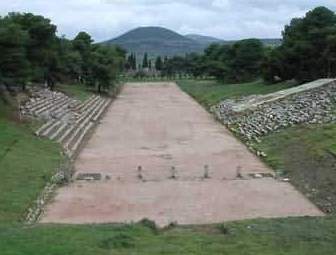
Epidaurus
Epidaurus (Epidauros) was a small city (polis) in ancient Greece at the Saronic Gulf. Epidaurus was independent of Argos and not included in Argolis until the time of the Romans. With its supporting territory it formed the small territory called Epidauria. Reputed to be the birthplace of Apollo's son, Asklepios the healer, Epidaurus was known for his sanctuary situated about five miles from the town, as well as its theater, which is once again in use today. The cult of Asklepios at Epidaurus is attested in the 6th century BC when the older hill-top sanctuary of Apollo Maleatas was no longer spacious enough.

Epidaurus Theater, designed by Polykleitos, c. 330 BC, 14000 seats at a sacred area of Asklepios
The asclepieion at Epidaurus was the most celebrated healing center of the Classical world, the place where ill people went in the hope of being cured. To find out the right cure for their ailments, they spent a night in the enkoimitiria, a big sleeping hall. In their dreams, the god himself would advise them what they had to do to regain their health. There are also mineral springs in the vicinity which may have been used in healing.
Asklepios, the most important healer god of antiquity, brought
prosperity to the sanctuary, which in the 4th and 3rd BC embarked
on an ambitious building program for enlarging and reconstruction
of monumental buildings. Fame and prosperity continued throughout
the Hellenistic period. In 87 BC the sanctuary was looted by the
Roman general Sulla and in 67 BC it was plundered by pirates. In
the 2nd century AD the sanctuary enjoyed a new upsurge under the
Romans, but in AD 395 the Goths raided the sanctuary.
Even after the introduction of Christianity and the silencing
of the oracles, the sanctuary at Epidauros was still known as
late as the mid 5th century, though as a Christian healing
center.
The prosperity brought by the Asklepieion enabled Epidauros to
construct civic monuments too: the huge theater that delighted
Pausanias for its symmetry and beauty, which is used once again
for dramatic performances, the ceremonial Hestiatoreion, baths
and a palestra. The theater was designed by Polykleitos the
Younger in the 4th century BC. The original 34 rows were extended
in Roman times by another 21 rows. As is usual for Greek theaters
(and as opposed to Roman ones), the view on a lush landscape
behind the skene is an integral part of the theater itself and is
not to be obscured.

Info From Wikipedia

